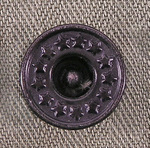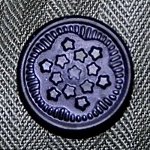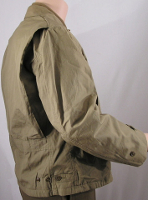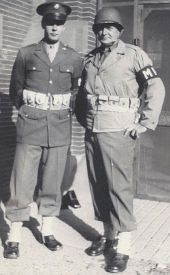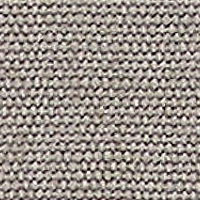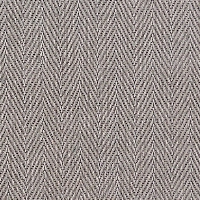#1 Early War US Army Basic Field Clothing (1941-1943)
This photo taken at Chanute AAF field in April 1944 is illustrative of the typical US Army field wear of the time period. The first man on the left wears the Olive Drab One-Piece Herringbone Twill Work Suit (Federal spec. BBB-S-786, dated 19 December 1938). The second man wears the Olive Drab Field Jacket (Spec. PQD 20B, dated 17 March 1942), and underneath is the newer Special OD One-Piece Herringbone Twill Work Suit that replaced BBB-S-786. Developed in 1942, the new one-piece suit featured patch pockets, which can be detected just below the man's jacket. The third man wears the Herringbone Twill Jacket (Spec. PQD 45B, dated 2 November 1942) and Trousers (Spec. PQD 42A, dated 30 October 1942). Note the doughnut hole tack buttons Work and field garments were fundamental uniforms necessary for the enlisted man to complete his basic training and to later carry out the functions he was trained to do. Thus, these uniforms were mandatory issue for the enlisted man upon induction into the army. Uniform requirements were again reviewed before embarking for a theater of operations. This practice was to ensure troops had in their possession the proper types and quantity of uniforms suitable for the environment they were about to enter. Mandatory allowances for the enlisted man included one field jacket, two pairs of wool trousers, one wool knit cap, and depending on occupation either two one-piece HBT suits, or two sets of HBT jackets and trousers. In the field, HBT was generally worn as a combat uniform in hot and tropical climates, or as a protective garment in cooler temperatures. It was also the primary garment used for fatigue duty. Field jackets and wool trousers were the primary uniform worn in cooler weather. Officers were not generally required to keep articles of field clothing while serving in the zone of interior. When deployed to a theater of operations, however, the field jacket was a mandatory purchase article, and depending on the climate, the HBT one-piece or two-piece uniforms were an optional purchase. Note the leisurely and relaxed appearance the men pictured present. In the 1941-42 period the Army Quartermaster issued many new types of specialized work and field uniforms. Many of these new issues were closely patterned after civilian designs in order to modernize the Army's image and improve morale. Once the new uniforms were standardized, the traditional wool service uniform became limited to dress and garrison use, and the blue denim working uniforms gradually disappeared. By contrast, other nation's armies continued to wear traditional woolen uniforms for both field and dress functions. Though, the WWII period saw considerable activity among the warring nations in the development of specialized field clothing, none were able to successfully develop and distribute these new types of garments in the numbers or scale the US military did. As a consequence, the GI of WWII often lacked the homogeneous appearance so strongly characteristic of military organizations. The new look US service men took to the field during this period was largely the result of an amalgamation of several concepts. Quartermaster clothing development began to make use of advances in clothing science and technology and mix them with improved design elements to produce field uniforms that exhibited not only improved utility, but morale boosting qualities as well. For example, textiles were selected for their attributes such as durability, protectiveness, heat retention, moisture ingress and egress, and wind resistance. An improvement in comfort was achieved by the use of expansion pleats and roomier patterns. Another feature frequently designed into garments at this time was the bi-swing back The development and subsequent adoption of the Olive Drab Field Jacket |
Chanute Field, Illinois: In this 1944 shapshot US Army Air Force personnel pose outside the barracks wearing various articles of work and field clothing. These loose fitting garments give them a relaxed and leisurley appearance. Hover on the photo for an expanded view.
To further assist in protecting against the elements, adjustment tabs were located at the cuffs and waist. The jacket's hip length and bi-swing back features were intended to allow the soldier's body a greater range of movement and comfort when engaged in field work. These where some of the key features brought to life when the first real field specific uniform was created by the Army. Over time, trouser crotch and seat areas were set lower and wider to better facilitate squatting and bending. The standard woolen service trousers were gradually redesigned with field use as their primary function where they would better compliment the new field jackets. Cotton herringbone twill Fashion elements used in the newly designed uniforms of 1941-42 borrowed heavily from similar clothes in the commerical market. A good example of this can be seen in our picture by examining the man's jacket that stands furthest to the right. His jacket, the first issue herringbone twill jacket (Spec. PQD 45, dated 3 April 1941), was styled very similar to civilian blue jean jackets of the day. Notice the false box expansion pleats on the pockets; they were there purely for visual effect as can be seen by items in his right pocket not causing the pleat to expand despite the pocket's fullness. Also, notice the shirt style cuffs and darts just above them, as well as the double button waistband. Even the new burst of glory button used on this design was detailed to instill pride and promote positve morale. Few of these early fashion elements would last long, however. In fact, none of the civilian styling in the early herringbone twill jacket would survive its next major make-over, as can be seen when comparing the jacket worn by the man on the far right to the one the man in the middle is wearing. The general appearance of the Olive Drab Field Jacket was also very similar to civilian wind breakers popular at the time. Its short length, lapel collar, zippered front, slash pockets, and rear half-belt were style elements adopted directly from civilian designs. These features would not last long either; all would be dropped in the next generation field jacket as utility and combat effectiveness became crucial. Although these uniforms were produced in enough quantity to be seen throughout the war, by the time this picture was taken in 1944 they were being replaced in favor of re-worked and improved designs, especially for front line troops. As real-world combat results were evaluated on the early war designs, changes came fast and furious. Style and fashion elements yielded in heavy deference to ergonomics. Colors were changed to enhance camouflage properties. Material characteristics such as durability, shrink resistance, composition, and weight became even more important; further improving new designs. Also, as the wartime army grew tremendously, a major driver of new designs became the conservation of materials. Non-essential features usually succumbed to the need to conserve materials in order to meet production demands. Finally, the good intentioned desire to outfit each specialized force with its own unique uniform designs led to an overabundance of clothing varieties. This practice made procurement and distribution of clothing impractical in a global war situation. Realizing this guided efforts to simplify the inventory of special uniforms by producing superior garments that could truly fill multiple roles without compromise. The Herringbone Twill uniforms shown in this photo gave way to new simplified designs with darker colors. The OD Field Jacket was replaced by the vastly improved and radically new M-1943 Field Jacket. The Knit Wool Cap, as well as many other caps of the day, gave way to the OD Cotton Field Cap with Visor. The earlier pre-war incorporation of fashion elements into military design made for some unique and interesting clothing for an expanding Army concerned with making mass mobilization palatable to the average citizen. Ironically, these pre and early war uniforms that borrowed heavily from civilian fashions of the time later became fashion drivers themselves. Their influence on leisure and outdoor wear designs can often still be seen today. These enduring designs are, without doubt, a lasting testament to the Quartermaster Corps' pre-war effort to improve the design, comfort, and utility of army uniforms. |
